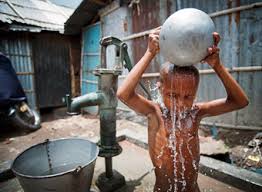Introduction:
The basic needs of human are –food, clothing, shelter, education, and health.
Education is essential for human and one of the basic needs of human being.
Education in its broadest sense is any act or experience that has a formative effect on the mind, character or physical ability of an individual. In its technical sense education is the process by which society deliberately transmits its accumulated knowledge, skills and values from one generation to another.
Teachers in educational institutions direct the education of students and might draw on many subjects, including reading, writing, mathematics, science and history. This process is sometimes called schooling when referring to the education of teaching only a certain subject, usually as professors at institutions of higher learning. There is also education in fields for those who want specific vocational skills, such as those required to be a pilot. In addition there is an array of education possible at the informal level, such as, in museums and libraries, with the Internet and in life experience.
Systems of formal education:
Education is a concept, referring to the process in which students can learn something:
- Instruction refers to the facilitating of learning toward identified objectives, delivered either by an instructor or other forms.
- Teaching refers to the actions of a real live instructor designed to impart learning to the student.
- Learning refers to learning with a view toward preparing learners with specific knowledge, skills, or abilities that can be applied immediately upon completion.
Education arena in Bangladesh is not so developed. Literacy rate is low and there is a significant disparity between female and male literacy rates. However, with on going awareness of both the government and NGO’s, literacy rate has been going up. Bangladesh gets International Literacy Prize 1998 from UNESCO for its ongoing literacy rate. It is targeted that, the country will be illiteracy-free by the year 2005.
The education system is divided into 4 levels– Primary (from grades 1 to 5), Secondary (from grades 6 to 10), Higher Secondary (from grades 11 to 12) and tertiary. Alongside national educating system, English medium education is also provided by some private enterprises. They offer ‘A’ level and ‘O’ level courses. There is also Madrasa system which emphasizes on Arabic medium Islam-based education. This system is supervised by the lone Madrasa Board of the country.
In 1998 there were about 52,000 primary schools 11000 secondary institutions. The five years of lower secondary education concludes with a Secondary School Certificate (SSC) examination. Students who pass this examination proceed to two years of Higher Secondary or intermediate training, which culminate in a Higher Secondary School (HSC) examination. Five education boards lead by the Ministry of Education deal with education up to HSC level.
Under-graduate level is finished with HSC. Then begins graduation level which is dealt by universities. Universities also offer Master’s and Doctorate degrees.
There are 11 government universities and approximately 20 private universities in Bangladesh. Specialized universities are Bangladesh University of Engineering and Technology (BUET), Bangladesh Agricultural University and Bangabandhu Shaikh Mujib Medical University.
On the other hand, health facilities are also important for human.
Health is the general condition of a person in all aspects. It is also a level of functional or metabolic efficiency of an organism, often implicitly human.
At the time of the creation of the World Health Organization (WHO), in 1948, health was defined as being “a state of complete physical, mental, and social well-being and not merely the absence of disease or infirmity”.
Only a handful of publications have focused specifically on the definition of health and its evolution in the first 6 decades. Some of them highlight its lack of operational value and the problem created by use of the word “complete.” Others declare the definition, which has not been modified since 1948, “simply a bad one.”.
In 1986, the WHO, in the Ottawa Charter for Health Promotion, said that health is “a resource for everyday life, not the objective of living. Health is a positive concept emphasizing social and personal resources, as well as physical capacities.” Classification systems such as the WHO Family of International Classifications (WHO-FIC), which is composed of the International Classification of Functioning, Disability, and Health (ICF) and the International Classification of Diseases (ICD) also define health.
Overall health is achieved through a combination of physical, mental, emotional, and social well-being, which, together is commonly referred to as the Health Triangle.
It is obvious that education and health facilities are very important for man. sometimes in Bangladesh it is seen that, lack of cleanliness or dirtiness of school latrines and lack of safe water supply creates some problems for the students for which they avoid to use school latrines; which generates some health problems to the students in future. Especially to the female students.
Education is one of the basic needs of human. The persons how are educated, are always deprived from their rights and become a victim of discrimination in their employment, and leads a backward life. So to develop their livelihood education is compulsory.
And the foundation of education is school. At present, from the realization of the necessity of education many schools are established, but they dot maintain a minimum standard and do not provide sufficient facilities, which are necessary for the mental development and physical fitness of the students.
Aims And Objectives Of The Study:
Investigate the health problems of school going students and their underlying causes:
(a) food
(b) sanitation
(c) water supply
o investigate the relation between this particular facilities and school absence.
Methodology Of The Study:
To extract real phenomena, research is most easiest and traditional systems. Several procedures are needed in completion of any research. The ultimate result of a research depends on overall procedures. So adjustment between objective and procedures is an important issue. Generally research can be considered as a scientific process to get vast knowledge about a certain thing.
Accurate and dependable information are needed for obtaining true knowledge about something. Data collection is the most important part to perform a research. For this reason in various researches, many type of data are collected to meet up objectives.
There is a vast scope in geography and environment as a discipline, in geographical research man, nature; environment and spatial discrimination are priority full. In geographic research, research methodology is constructed after based on physical, social and economic situation of a certain area. For this reason different methodology are made for different places.
“Water Supply And Sanitation Sector In The Schools Of Wari Area” is the title of present study which is conducted based on field data and secondary data. To perform the present study following procedures were followed:
DATA SOURCES:
This research is based on both primary and secondary data. Primary data were collected through field work. And secondary data were collected form various sources, such as; books, magazines, various published unpublished materials or internet.
PRIMARY DATA:
To capture primary data from the students of the survey area questionnaire survey was conducted.
SECONDARY DATA:
To fulfill the aims and objectives of the present study, the importance of secondary data are very essential. In this research, secondary data were used which are generally published by various institutions and researchers. Various published and un published information’s, file research paper and data were also used here. More over water supply and sanitation problems, education, health related books, published unpublished journals, internet articles were explored thoroughly.
ANALYSIS OF PRIMARY DATA:
After collecting data by the questionnaires and considering the purpose and objectives of the study, a classification was made according to similarities and dissimilarities. From the classification of raw data statistical series was prepared to present the collected and classified data in a properly arranged way.
Rationale Of The Study:
Public education in Bangladesh generally follows the model established by the British prior to 1947. Elementary education is free, but at least one-third of all children are not enrolled in school. Poor school attendance is a major reason for a literacy rate of only 35 percent for Bangladeshis aged 15 and older. In the period 1989 to 1990, the country had about 45,000 elementary schools, with a total annual enrollment of some 11.3 million pupils, and about 10,000 secondary schools, with a combined yearly enrollment of about 3 million.
Bangladesh has several universities, the largest of which is the University of Dhaka (1921). Others include Bangladesh University of Engineering and Technology (1962) and Jahangirnagar University (1970), both in Dhaka; Bangladesh Agricultural University (1961) in Mymensingh; the University of Chittagong (1966); and the University of Råjshåhi (1953). Colleges include Bangladesh College of Textile Technology (1950) in Dhaka, and Chittagong Polytechnic Institute (1962). In the period 1989 to 1990, the country’s colleges and universities together enrolled more than 500,000 students.
Bangladesh, in full, People’s Republic of Bangladesh, republic of southern Asia, in the northeastern portion of the Indian subcontinent, bordered on the west, north, and east by India, on the southeast by Burma (Myanmar), and on the south by the Bay of Bengal. The area of the country is 143,998 sq km (55,598 sq mi). The capital and largest city of Bangladesh is Dhaka.
Dhaka District (DHAKA division) with an area of 1463.60 sq km, is bounded by GAZIPUR and TANGAIL districts on the north, MUNSHIGANJ and RAJBARI districts on the south, NARAYANGANJ district on the east, MANIKGANJ district on the west.
Annual average temperature maximum 34.5°C, minimum 11.5°C; total rainfall 1931mm. Main rivers are Padma, Kaliganga, Dhaleshwari, Ichamati, Shitalakshya, Buriganga; small rivers are Bangshi, Turag, Balu, Elamjani, Alam, Bherujkha, Ramkrishnadi, Elisamari, Tulsikhali. Noted Beels Belai, Saldaher, Labandaher, Churain, Damsharan and Kiranjir Beel.
Dhaka stands(town) on the bank of the river Buriganga. It consists of seven principal thanas (DHANMONDI, KOTWALI, MOTIJHEEL, RAMNA, MOHAMMADPUR, SUTRAPUR and TEJGAON) and 14 auxiliary thanas (GULSHAN, LALBAGH, MIRPUR, PALLABI, SABUJBAGH, CANTONMENT, DEMRA, HAZARIBAGH, SHYAMPUR, BADDA, KAFRUL, KAMRANGIR CHAR, KHILGAON and UTTARA), 148 wards and 824 mahallas. It has an area of 304 sq km. The town has a population of Dhaka Statistical Metropolitan Area is 99,12,908 according to the Population Census 2001, Preliminary Report, BBs; male 55.24%, female 44.76%; population density per sq km 32608. Literacy rate among the town people is 62.3%.
Dhaka municipality was established in 1864 and was turned into a Town Committee in 1960. The name of the Town Committee was changed to Dhaka Municipality in 1972. It was turned into a Municipal Corporation in 1983. Finally it was elevated to City Corporation in 1991.
Dhaka is the capital city of Bangladesh. The town has 88 cinema halls, 351 clubs, 55 playground, 136 government and private hospitals and clinics, 4 parks, 4 national stadiums, 17 public and private universities, 4 government medical colleges, 11 private medical colleges. Other important establishments include Bangladesh Supreme Court, High Court, Judge Court, diplomatic missions of many countries, Bangladesh Secretariat, National Museum, National Zoo, and head offices of various sector corporations government departments, business houses and NGOs.
My study area is WARI area, which is located in Dhaka at Sutrapur thana.
Sutrapur Thana (DHAKA district) with an area of 3.51 sq km, is bounded by MOTIJHEEL thana on the north, KERANIGANJ upazila on the south, DEMRA thana on the east, KOTWALI thana (Dhaka) on the west. Main river is BURIGANGA.
Population:
292326; male 57.33%, female 42.67%; Muslim 87.30%; Hindu 12.24% and others 0.46%; population density per sq km is 83284.
Literacy and educational institutions:
Average literacy 58.9%; male 61.1% and female 56%. Educational institutions: college 7, medical college 1, school 15, madrasa 10, primary school 18, technical institution 1. Noted educational institutions: KL Jubili School & College (1866), Government Muslim High School (1874), St. Gregory High School (1882), Dafrin Hostel (1906), St. Francis Xaviers Girls High School, Suhrawardi College.
Cultural organizations:
Club 25, theatre stage 1, theatre group 3, literary society 5, women’s organisation 6, public library 2, most noted of which is North Brook Hall.
Locally published newspapers and periodicals:
Dainik Ittefaq, Dainik Inquilab, Daily New Nation, Weekly Rabbar and Weekly Purnima.
Land use:
Residential 32%, office 5%, commercial 18%, market & business centre 37%, public use 5%, low lying marshy land 0.8%, fallow land 0.9%, others 1.3%.
Religious institutions:
Mosque 50, temple 10, church 3, tomb 10, most noted of which are Sutrapur Jami Mosque, Bibika Rauja Mazar, Gaurio Math Mandir, Ramkrishna Mission and Baptist Church.
The area Wari is located in Sutrapur thana (Dhaka district). Baldha Garden- an exotic botanical garden on 3.15 acres of land located at Wari. There are two hospitals, one sub Post Office, one Police Fari are located at wari.
Safe water supply, good sanitation problems facilities, adequate sports facilities beside education – are very important for the mental growth and physical fitness of the students of the school.
From the above chart, it is seen that the number of students in the schools of Wari area are not bad. So, it is very important to know the water supply and sanitation problems facilities of these schools.
SANITATION:
It is recognized that for schools, water and sanitation problems facilities are important and that hygiene education should be part of the curriculum, recurring in different subjects and referred to by authority figures. In practice, however, the situation in many schools in developing countries is deplorable. The sanitation problems are non-existent or very poor, sometimes even unsafe, and a cause of much disease. The children in these countries acquire early on a heavy infectious load. Schools should not be adding to it. Infections impair the growth and development of the children, limit their attendance and negatively affect their ability to concentrate and learn.
Water supply system in wari area is good, water is available here all day long. For this, these schools have no water problem and in the latrines of these schools water is available all time.
These diagram shows the number of latrines in the schools of Wari area.
From these diagram, Silverdel Preparatory & Girls High School has 20 latrines; Little Scholar’s Tutorial & High School has 5 latrines; Moitry kindergarten, Wari High School and New Bird Kindergarten has 4 latrines each, Islamia Model Govt. primary school and Wari Govt. Girls Primary School has 3 latrines each. And Alamin Pre-Cadet & High School has 2 latrines.
These pie diagram shows, percentage of student’s opinion about the number of latrines in the school.
57% student says that, the number of latrine they have in their school are not sufficient, but 43% says that they are sufficient.
From the investigation it is seen that, there is no school where the latrines are washed and cleaned every day. In Wari High School latrines are washed and cleaned every Thursday, in Silverdel Preparatory & Girls High School and Little Scholar’s Tutorial & High School- latrines are washed and cleaned thrice a week, in Moitry kindergarten and New Bird Kindergarten School- latrines are washed and cleaned twice a week, And in Islamia Model Govt. primary school, Wari Govt. Girls Primary Schol and Alamin Pre-Cadet & High School- latrines are washed and cleaned once a week.
From the investigation, it is known that, school latrines are not comfortable for all students.
The diagram shows that, about 70% student says that school latrines are uncomfortable for them and 30% says that they have no problem to use school latrines.
The reasons of uncomfortable are – dirtiness, lack of water supply, for getting fear, and many other reasons.
These graph shows that 42.85% students are uncomfortable to use school latrines, because of getting fear, 39.28% students are uncomfortable because of dirtiness, and 17.58% students are not use school latrines for many other reasons.
In the previous chapter, data have been analyzed and interpreted to arrive at the findings of the study. The major findings based on the previous chapter are listed below. Based on the findings, the recommendations of the study are given next to the findings. Limitations of the study are listed in the last section of this chapter.
MAJOR FINDINGS:
From the investigation it is found that, most of the student likes the teaching method and environment of the school.
And most of student of these schools attends regularly in school, but sometimes they miss school especially for sickness.
Most of these schools have no play ground and if they have play ground it is not sufficient, which pays a bad effect to the mental growth of the students.
Canteens of these schools does not serve hygienic food, and for this students are getting affected by different types of diseases.
Students bring drinking water from home, because most of the school serves students tap water, which is not safe.
It is a matter of concern that, these schools are not clean their latrines everyday. And for these the latrines of these schools are very dirty and had a bad smell. And for this reason many of the student are not comfortable to use their school latrines.
RECOMMENDATIONS:
a) Excess pressure of education on the students should be reduced.
b) Adequate play ground and recreation facilities should be provided for the mental growth and physical fitness of the students.
c) School authority should be careful to maintain the quality of canteen food.
d) Every school should arrange to supply filter water to the students.
e) The school authority should increase the number of latrines where there is scarcity of latrines.
f) School authority should arrange to clean the latrines everyday and supply safe water in the latrines all time.
g) Encourage students in motivating their family members and neighbors to use safe water and sanitary latrines, to avoid diseases.













